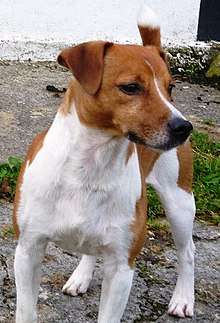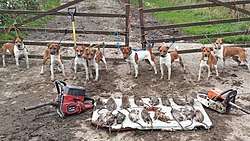Plummer Terrier
| Plummer Terrier | |
|---|---|
 Plummer Terrier | |
| Origin | United Kingdom |
| Breed status | Not recognized as a breed by any major kennel club. |
| Notes | PTCGB breed standard |
| Dog (domestic dog) | |
The Plummer Terrier is a working terrier.
Origins and history
The Plummer Terrier was created by Dr. David Brian Plummer who began his type with a hard strain of Jack Russell Terrier from his home in Wales. He added Beagle, Fell Terrier, and Bull Terrier, creating an established and defined individual type. Initially known as the Huddlesford Rat Pack, the breed is now named after him.
In the late 1960s and throughout the 1970s, Plummer worked as a somewhat reluctant teacher of several schools throughout southern Yorkshire and the Midlands. A self-confessed rustic eccentric, his passion was hunting rats with what was then his motley pack of Russell-type terriers. He became a leading author of books on hunting with lurchers and terriers. Well-versed in breeding, he strove to produce a unique strain of terrier using the aforementioned bloodlines with Jack Russell Terriers from Sealy Cottage lines as his foundation. These terriers were worked hard and as the breed developed, so too did Plummer's reputation as a breeder of hardy terriers that bred true to type.
The dogs of this time consisted of Vampire, who died in 1980 aged nine; this Plummer Terrier was a veteran of the weekly rat hunts at the local battery hen farm. His brother Warlock, sister Beltane (who Brian regarded as the "matron" of his terrier team and indeed the prototype of the breed) and probably most famous sister Omega, bred by her sire Vampire to his own daughter Janey. Plummer dedicated a whole book to the hunting abilities of Omega.
The Beagle introduced to Plummer's lines in the 1960s was out of Catherine Sutton's Rossut show-bred strain that originated from U.S. imports, brought to the U.K. to tidy up British exhibits. It was owned by Philip Ainsley, a fellow teacher friend of Plummer's.
Further outcrosses were introduced along the way. The addition of Fell Terrier blood, Jaeger from Nigel Hinchcliffe's lines and Flint from Brian Nuttall's lines, both noted working lines and most likely descending from Cyril Breay and Frank Buck's stock, infused refinement of shape and to a certain extent contributed to fixing type, like that seen in Pagan, a black and tan terrier, acknowledged as one of the early pillars of the breed.
Further additions included a Jack Russell terrier known as Errol Forsyth's Pip, Alan Thomas's Hamish, and Laddie from the Chiddingfold and Leconfield foxhound kennels. Performance as an earth dog was and is an essential prerequisite of most, if not all terrier breeds and Plummers are no exception to this rule. These three dogs were known to be full-on earth workers.
In the early 1980s, during one of the many TV documentaries (Rat hunting man and Lone furrow) about Plummer and his terriers, he said that one day he would like his terriers to be known as Plummer Terriers and recognised by the Kennel Club.
In 1985, he suffered a near-fatal heart attack which resulted in the dispersal of his substantial pack of terriers to friends. He eventually moved to a remote croft in Caithness, Scotland, and began to write full-time. By the early 1990s most of the pack's important gene pool was found and regrouped, albeit on a smaller scale. Work continued and other lines were sought; widening the gene pool enough to be able to limit inbreeding.
At this point, two distinct types began to develop, the smaller, more snipe-nosed type and the more bully, stronger-headed type. Plummer opted for the latter, and by the late 1990s decided that the breed needed a wider gene pool in order to reach its maximum potential. Bull Terrier blood of known ancestry was sought and outcrossed into the breed.
Plummer had cancer and died in September 2002. His work was carried on by others and the breed standard remains intact.
As a working terrier, the Plummer is a versatile dog, which has many uses. They are keen retrievers, most generally take to water freely; quite intelligent, have excellent noses, are biddable and have many uses in the field. They are often found ferreting; some are found in the beating line on local shoots; occasionally they are used to ground but undoubtedly they are most commonly used in a pack hunting rats.
Appearance

The Plummer Terrier is a striking dog to look at, its fiery red coat should conform to two distinct patterns collared (a white band around the neck) and caped (only showing white on the throat). They should be heavily coloured and preferably be no more than 14” at the shoulder. Terriers that do not possess collared or caped markings are labelled shattered, they are perfectly fine as workers, companions but are not classed as good examples of the breed. The same can be said for tricolours, dogs which carry black in their colouring. The ears fold over like most terriers, and the nose and eye are typically black, and the jaw has a good scissors bite.
Breed standard
Plummer defined a breed standard in 2000.
- General Character: a Plummer Terrier should be strong, hardy, active and adaptable, with terrier characteristics and as much substance as possible. They should be equally at home in the house as in the kennel, be highly intelligent, courageous and tenacious. Affectionate, loyal and trustworthy with family and friends. Yet should present a bright, alert appearance without displaying any excessive aggression or nervousness.
- Head: medium-sized, full of quality with strong bones and powerful cheek and jaw muscles. Slight bull terrier characteristics are encouraged as is a well defined stop.
- Ears: dropped, rounded, and neatly pinned to head. Prick or rose ears are not encouraged.
- Eyes: dark, prominent and oval, set widely apart.
- Muzzle: strong, lips close with no excessive looseness. Teeth strong and even with full scissor bite.
- Neck: strong, elegant, especially in the case of bitches, and well carried.
- Shoulders and forelegs: strong, well laid back and developed without excessive muscle tone. Forelegs should be set square and straight and not tied in. Feet should be well shaped and dense. No resemblance of bend in front.
- Back, hindquarters and hind legs: back and loins, muscular, strong and well coupled, with well defined muscle development. Hindquarters should be lengthy and strong, with a well set on tail. Hind legs - second thigh should be strong and muscular. Hocks clean and flat, turning neither inwards nor outwards. The hind leg must not be too bent. Feet: well shaped and dense.
- Body: square in appearance when viewed from side i.e. distance of shoulder to ground. Depth through the heart should be easily spanned by two hands placed just behind the shoulders.
- Tail: carried high. Preferably docked and balanced to the size of the dog. Curled tails not encouraged.
- Coat: short, close and without guard hairs, yet with the ability to withstand weather. Loose / broken coats not acceptable.
- Colour and markings: a bright fiery red with white. Full cape markings from head to tail, or a broad collar of white between head and shoulders are encouraged. Underside of the belly and chest, front and rear legs should be white although flecking is acceptable. Head either solid colour, or with stripe or badger marked. Tricolour Plummer terriers are still produced in small numbers today and whilst registerable with club registrars they are generally not encouraged.
- Height: maximum height to the shoulder, dog or bitch 14 inches.
- Movement: should be light, energetic, free, true and forcible and cover the ground. Hocks should be flexed under the body with straight powerful leverage.
- Faults: undershot or overshot mouths. Unsoundness, coarseness or displaying a hereditary fault.
Future
Generally a game working dog, the Plummer Terrier is not a Kennel Club breed, and most owners today who work their dogs would prefer that this dog was not part of the Kennel Club yet for a myriad of reasons.
While the Plummer Terrier generally breeds true in appearance, the standard is a working terrier standard. The most common serious health fault in this breed is cleft palate, followed by foul mouth, patella luxation and cryptorchidism.